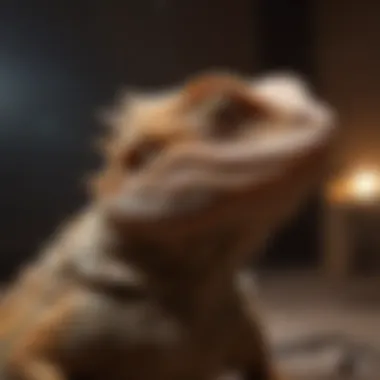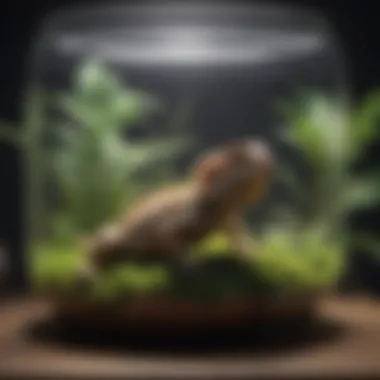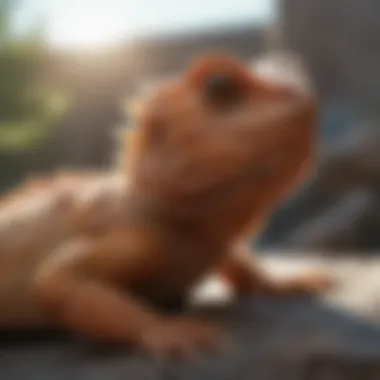Uncovering the Lighting Needs of Bearded Dragons: A Comprehensive Guide


Animal Species Profile
When delving into the world of bearded dragons, it is fascinating to discover a species that captivates reptile enthusiasts with its unique attributes. Bearded dragons, scientifically known as Pogona, are popularly kept as pets due to their amiable nature and intriguing behaviors. These reptiles boast captivating physical characteristics, including a triangular-shaped head, wide-set eyes, and rough, spiky scales that resemble a dragon's beard, hence their name. Originating from the arid deserts of Australia, bearded dragons thrive in dry, rocky terrains and open forests, where they bask in the sunlight to regulate their body temperature. Their innate curiosity and sociable demeanor make them intriguing companions for those interested in keeping reptiles, as they exhibit a range of behaviors from territorial disputes to gentle communication through body language.
Conservation & Wildlife Efforts
While bearded dragons are commonly bred in captivity, their wild counterparts face significant challenges in their natural habitat due to habitat loss, introduced predators, and climate change. As a result, the conservation status of certain bearded dragon species is a cause for concern, indicating a need for conservation initiatives to protect their dwindling populations. Various organizations are working tirelessly to safeguard these reptiles through habitat restoration projects, captive breeding programs, and public awareness campaigns. By addressing the threats posed to bearded dragons in the wild and implementing conservation strategies, these initiatives aim to ensure the long-term survival of these iconic reptiles in their natural ecosystems.
Animal Behavior & Psychology
Understanding the behavior and psychology of bearded dragons provides valuable insights into their social interactions and cognitive abilities. These reptiles employ a range of communication cues, including head bobbing, arm waving, and color changes, to convey messages to conspecifics and humans alike. During mating season, male bearded dragons engage in elaborate courtship displays to impress females and establish dominance within their territories. Furthermore, studies have revealed that bearded dragons possess problem-solving skills and exhibit emotional intelligence through their responses to stimuli and social dynamics. By examining the intricate behavior patterns of these reptiles, researchers gain a deeper appreciation for the complexities of bearded dragon psychology and social behavior.
Unique Facts & Trivia
Uncover the intriguing world of bearded dragons with a collection of little-known facts and quirky behaviors that set them apart from other reptiles. Did you know that bearded dragons are capable of changing their skin color to regulate their body temperature and communicate their moods? These reptiles also exhibit a fascinating behavior known as 'glass surfing,' where they repetitively run against the walls of their enclosure, possibly indicating stress or boredom. In addition to their unique behaviors, bearded dragons are known for their exceptional climbing abilities and skilled hunting techniques, making them versatile predators in their natural habitat. From their impressive feats of agility to their quirky habits, bearded dragons never fail to surprise and delight observers with their captivating nature.
Pet Care & Tips
For aspiring bearded dragon owners, providing optimal care and creating a suitable habitat are essential for the well-being of these reptilian companions. When selecting a pet, it is crucial to choose a healthy individual from a reputable breeder or rescue organization to ensure a strong start for your new companion. Basic care requirements include providing a spacious enclosure with adequate heating and lighting, a nutritious diet of insects and leafy greens, and regular veterinary check-ups to monitor your pet's health status. To promote behavioral enrichment, consider implementing climbing structures, hiding spots, and interactive toys in the habitat to stimulate your bearded dragon's natural behaviors and psychological well-being. By following these care tips and best practices, you can create a nurturing environment for your bearded dragon and forge a rewarding bond with your scaly friend.
Overview of Bearded Dragons
Basic Information
Bearded dragons, scientifically known as Pogona, are native to Australia and are popular exotic pets due to their docile nature and interesting behaviors. These reptiles are known for their distinctive appearance, with spiky scales that resemble a beard around their throats. Understanding the basic information about bearded dragons, such as their dietary preferences, lifespan, and size, is essential for providing proper care in captivity.
Habitat
Creating a suitable habitat for bearded dragons is crucial for their overall health and well-being. In the wild, these reptiles inhabit arid regions, so replicating a similar environment in captivity is vital. A proper habitat should include a spacious enclosure with basking spots, hiding places, and appropriate substrate. Maintaining the correct temperature and humidity levels is essential to ensure the comfort of your bearded dragon.
Behavior
Bearded dragons exhibit intriguing behaviors that can provide insight into their health and mood. From head bobbing to arm waving, these reptiles have unique ways of communicating. Understanding their behavior patterns, such as feeding habits, social interactions, and territorial displays, can help you create a stress-free environment for your bearded dragon.


Importance of Proper Lighting
Role in Health
Proper lighting plays a significant role in the overall health of bearded dragons. Adequate exposure to UVB light is essential for the synthesis of vitamin D3, which is crucial for calcium metabolism and preventing metabolic bone disease. Ensuring that your bearded dragon has access to proper lighting can help prevent various health issues and promote overall well-being.
UVB Requirements
UVB lighting is a critical component of a bearded dragon's lighting setup. These reptiles require UVB rays to metabolize calcium effectively and maintain healthy bones. When selecting UVB bulbs, opt for reputable brands that provide the appropriate UVB output suitable for bearded dragons. Proper placement of UVB lights within the terrarium is essential to ensure that your reptile receives the necessary UVB exposure without being blocked by barriers.
Heat Regulation
In addition to UVB lighting, adequate heat sources are crucial for maintaining the proper temperature gradient within the terrarium. Bearded dragons require basking lights to create a warm basking spot where they can regulate their body temperature. Monitoring the temperature gradients in the enclosure and providing thermal gradients will help mimic the natural conditions that bearded dragons experience in the wild.
Types of Lights
When delving into the critical topic of 'Types of Lights' for bearded dragons, it is essential to understand the pivotal role that lighting plays in the health and well-being of these reptiles. Different types of lights serve specific functions to cater to various needs such as UVB exposure and basking requirements. Selecting the right types of lights is crucial for replicating their natural habitat and ensuring optimal growth and development for these reptilian companions.
UVB Lighting
Function
Exploring the function of UVB lighting unveils its key role in facilitating the production of vitamin D3 in bearded dragons, essential for calcium absorption and metabolic processes. UVB lighting mimics natural sunlight, contributing to the overall health and vitality of these reptiles. The unique feature of UVB lighting lies in its ability to simulate natural UV rays, promoting bone health and preventing conditions like metabolic bone disease.
Recommended Brands
When considering UVB lighting for bearded dragons, reputable brands like Zoo Med, Arcadia, and Reptisun stand out for their quality and efficiency. These brands offer a range of UVB bulbs tailored to the specific needs of bearded dragons, ensuring adequate UV exposure and promoting overall well-being. Emphasizing the importance of investing in reliable UVB bulbs, these recommended brands deliver the necessary spectrum of UVB light crucial for the health of bearded dragons.
Proper Placement
Proper placement of UVB lighting within the terrarium is critical to ensure optimal exposure for bearded dragons. Positioning the UVB bulb at the appropriate distance and angle relative to basking spots is vital for achieving the required UVB levels. Placing the UVB light too far or too close can result in inadequate exposure or potential harm to the reptiles. Understanding the unique UV requirements of bearded dragons is key to determining the proper placement of UVB lighting for their well-being.
Basking Lights
Purpose


Basking lights serve the essential purpose of creating a localized heat source within the terrarium, allowing bearded dragons to regulate their body temperature effectively. The primary function of basking lights is to provide the necessary heat gradient for thermoregulation, enabling bearded dragons to maintain optimal body temperatures for digestion and overall physiological functions. By simulating the warmth of sunlight, basking lights offer a comfortable basking spot for bearded dragons to rest and thermoregulate.
Temperature Guidelines
Adhering to temperature guidelines ensures that basking lights achieve the desired thermal gradients needed for bearded dragons. Maintaining a basking area temperature around 95-110°F (35-43°C) allows reptiles to bask comfortably and regulate their body temperature efficiently. Monitoring and adjusting the distance and wattage of basking lights are crucial for maintaining the appropriate basking temperatures essential for the health and well-being of bearded dragons.
Setting Up the Lighting Environment
Understanding the significance of Setting Up the Lighting Environment is paramount in this article as it directly impacts the well-being of bearded dragons. Proper lighting ensures the reptiles receive essential UVB rays for their health and aids in maintaining optimal temperatures within their habitat. By focusing on the specific elements of lighting setup such as UVB and basking lights, this section delves into the crucial aspects of creating a suitable environment for these reptiles.
Terrarium Setup
Position of Lights
The Position of Lights holds a pivotal role in providing the necessary lighting conditions for bearded dragons. Placing the lights strategically ensures even distribution of UVB rays and maintains appropriate temperatures throughout the terrarium. This aspect is vital for replicating their natural habitat and promoting healthy behaviors. Positioning the lights at specific angles helps in mimicking the sun's path and creating designated basking spots for the dragons. Consequently, this promotes a balanced environment that supports their overall well-being.
Lighting Schedule
Establishing a proper Lighting Schedule is essential for regulating the day-night cycle for bearded dragons. Maintaining a consistent lighting schedule mimics their natural habitat and helps in regulating their biological clock. Ensuring the right amount of light and darkness hours aids in managing their basking and resting periods effectively. This schedule not only influences their activity levels but also plays a crucial role in their overall health and behavior. Monitoring and adjusting the lighting schedule according to their needs contribute significantly to their overall well-being.
Temperature Regulation
Thermometers
Utilizing Thermometers in the terrarium is crucial for monitoring and maintaining the ambient temperature for bearded dragons. These devices provide real-time temperature readings, ensuring that the habitat remains within the ideal temperature range for the reptiles. By placing thermometers in different areas of the terrarium, it helps in identifying temperature gradients and adjusting the lighting setup accordingly. This precise temperature regulation is essential for preventing health issues related to inadequate heating or cooling within the habitat.
Thermostats
Incorporating Thermostats in the terrarium setup offers added precision in temperature control for bearded dragons. Thermostats work in conjunction with heating elements to regulate temperatures consistently, providing a comfortable environment for the reptiles. The use of thermostats ensures that the heating sources do not exceed or fall below the set temperature thresholds, preventing any potential harm to the dragons. This additional layer of temperature regulation enhances the overall efficiency and safety of the lighting setup, promoting a stable and healthy ecosystem for the bearded dragons.
Common Mistakes to Avoid
Inadequate Lighting
Consequences:


Inadequate lighting can result in a myriad of issues for bearded dragons. One of the main consequences is the development of metabolic bone disease, a serious condition caused by a lack of UVB light, essential for calcium absorption. This deficiency can lead to weakened bones, malformations, and even death in severe cases. By understanding the significance of providing adequate lighting, pet owners can help prevent such detrimental health effects on their bearded dragons.
Recognizing Issues:
Recognizing the signs of inadequate lighting is essential for proactive pet care. Symptoms like lethargy, lack of appetite, and difficulty in shedding skin can indicate a deficiency in the lighting setup. Being vigilant about these signs and taking prompt action to address any lighting issues can significantly improve the well-being of your bearded dragon.
Overexposure to Light
Health Risks:
Overexposure to light can pose serious health risks for bearded dragons. In particular, excessive exposure to UVB radiation can lead to skin burns, eye problems, and a heightened risk of developing skin cancer. It is vital to adhere to recommended lighting durations and intensities to avoid subjecting your pet to unnecessary health hazards.
Signs of Overexposure:
Detecting signs of overexposure to light is crucial in maintaining the health of your bearded dragon. Symptoms such as reddening or peeling skin, excessive basking, and increased stress levels can indicate that your pet is receiving too much light. By monitoring your pet's behavior and physical condition, you can promptly adjust the lighting settings to prevent overexposure and safeguard your bearded dragon's well-being.
Monitoring and Maintenance
In this section, we delve into the pivotal aspect of monitoring and maintaining the lighting setup for your bearded dragon. Proper monitoring and regular maintenance play a crucial role in ensuring the health and well-being of your reptilian companion. By conducting routine checks and following a structured maintenance regimen, you can safeguard against potential issues and create a comfortable environment for your pet.
Regular Checks
UVB Bulb Replacement
When it comes to UVB bulb replacement, it is imperative to understand the significance of this task. UVB bulbs degrade over time, leading to a decrease in their output of essential UV rays necessary for your bearded dragon's health. Regularly replacing UVB bulbs ensures that your pet receives adequate exposure to UV radiation, vital for calcium metabolism and overall physiological functions. Choosing high-quality UVB bulbs from reputable brands is crucial to maintain optimal UV levels in the terrarium.
Cleaning Lights
Cleaning the lights in your bearded dragon's habitat is paramount to prevent the buildup of dust, dirt, and other contaminants that can obstruct the light output. Dirty lights diminish the effectiveness of UVB and basking light, compromising the overall lighting environment. Regular cleaning not only enhances the brightness and efficiency of the lights but also promotes a hygienic living space for your pet.
Seeking Professional Advice
Turning to veterinary professionals for input on your bearded dragon's lighting needs can offer valuable insights and guidance. Veterinarians specializing in reptile care can provide expertise on lighting requirements, bulb selection, and optimal terrarium setup. Their knowledge can help address specific health concerns related to lighting and ensure a tailored lighting setup that meets your pet's individual requirements.
Veterinary Input
Consulting with a veterinarian experienced in reptile care allows for personalized advice on bearded dragon lighting. Veterinarians can recommend suitable UVB and basking lights based on your pet's age, size, and health status. Additionally, they can assess the lighting environment for any potential shortcomings and offer solutions to enhance your bearded dragon's overall well-being.
Lighting Consultation
A lighting consultation with herpetological experts can provide in-depth guidance on creating a custom lighting setup for your bearded dragon. These consultations can involve assessing your terrarium layout, light positioning, and temperature regulation strategies. Expert recommendations on UVB exposure duration, basking spot temperatures, and light placement can significantly contribute to optimizing your pet's lighting environment.







